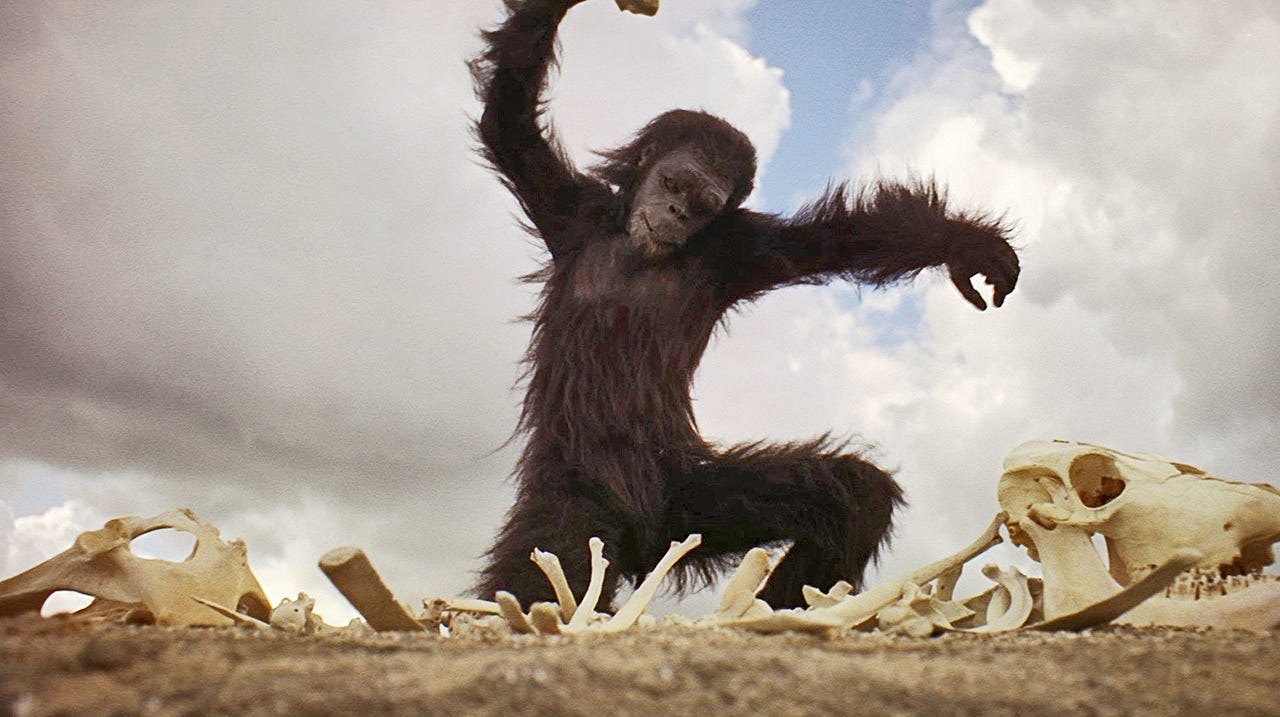2001: A Space Odyssey (1968), by Stanley Kubrik, is a bold and unusual film that uses incredibly realistic acting and effects from before the time of CGI. The story follows a mysterious monolith through space and time, as well as focusing on modern artificial intelligence going rogue - something humans have always feared.
Often described as an "unconventional plot" (Fox, 2011), the film may, at first, be a bit confusing for some when it opens up in the pre-human era, where ape-like creatures discover the monolith for the first time. The apes gradually evolve, discovering new tools and methods of survival. Although this beginning is wildly different from the rest of the film visually, (mainly because it's set on Earth instead of space) the picture is absolutely stunning, as are the scenes to come.
 |
| Fig. 1 |
Directly following the ape scene, the viewer is launched into the future where the monolith has been found in a crater on the moon. The story then continues to fast-forward to 18 months in the future, where a mission has been launched to Jupiter, the planet where the monolith's strange signals are heading towards. However, on this mission the artificial intelligence computer that controls the ship, known as HAL 9000, malfunctions and become creepily human-like, as well as cruel and violent. After HAL murdering four of the crew members on the ship, it is up to the remaining member, Dave, to shut off the AI for good. Dave succeeds in this and continues his mission to Jupiter where he finds an even bigger monolith. From there we are launched into an incredible light show which ends with Dave in a hotel room, quickly ageing in an eerie way, before becoming immortal in space.
The film isn't fast-paced: in fact, it's exactly the opposite. Kubrick takes his time to make beautiful scenes, which makes the movie feel like a work of art rather than a film. Although the story is, at times, hard to understand, Kubrick more than makes up for it with the stunning visuals. The story in 2001 is Kubrick's own; he doesn't embellish it or make it more 'mainstream' to please other people, and that is probably a big contribution to the success of the film. It isn't made to conform to other people's standards, it's made to stand out and be different.
 |
| Fig. 2 |
Kubrick has been more than meticulous about the film's appearance. He often uses symmetry and one-point perspective to make his shots look amazingly balanced. Not only this, but the use of music in the film really adds to it, using a range of classical pieces to describe different atmospheres. The music also makes up for the lack of speech as "the first spoken word is almost a half hour into the film, and there's less than 40 minutes of dialogue in the entire film" (Dirks, no date). Although the characters don't say much in the film, it's still obvious what they're doing and why, and this is all described through set design, acting, costume and music. It's amazing how Kubrick has managed to make a scene 'talk' without actually having any character physically speaking.
 |
| Fig. 3 |
At the end of the film, it is a lot more confusing, especially during the psychedelic scene that lasts for just under 10 minutes, followed by the slightly puzzling scene in the hotel/bedroom. "The film did not provide the clear narrative and easy entertainment cues the audience expected. The closing sequences, with the astronaut inexplicably finding himself in a bedroom somewhere beyond Jupiter, were baffling." (Ebert, 1997). Even though it can be difficult to understand, one of the main points is that it really makes you think about the story, what it means, and why the film was made in this way. 2001 really pulls attention to itself not only by its amazing visuals, but also by its unconventional and original story, which is something that not many films can do.
 |
| Fig. 4 |
Bibliography
Fox, K (2011). "My favourite film: 2001: A Space Odyssey". In The Guardian [online]. Available at: (https://www.theguardian.com/film/filmblog/2011/dec/12/favourite-film-2001-space-odyssey)
Dirks, T (no date). "2001: A Space Odyssey (1968)". In Filmsite [online]. Available at: (http://www.filmsite.org/twot.html)
Ebert, R (1997). "2001: A Space Odyssey". In Roger Ebert [online]. Available at: (http://www.rogerebert.com/reviews/great-movie-2001-a-space-odyssey-1968)
Illustration List
Fig. 1 - https://cdn-images-1.medium.com/max/2000/1*v3Fxrk0rzkuyD_R0VyhBVA.jpeg
Fig. 2 - https://nonamemovieblog.files.wordpress.com/2012/04/2001-dead-room.jpg
Fig. 3 - https://i.pinimg.com/originals/68/e5/d7/68e5d7737321931f486530ee5832d2c3.jpg
Fig. 4 - https://cmsplatypus.gothamist.com/gothamistgallery/2017/3/21/f3c592375img_0018-13-jpg.jpeg
Sounds like you enjoyed this film, Chloe :)
ReplyDeleteJust a quick point about your bibliography - you should order it alphabetically, so in this case, Dirks, Ebert then Fox. This becomes more important when you start to write essays that have drawn on lots and lots of sources!
Ok, thanks! :)
Delete